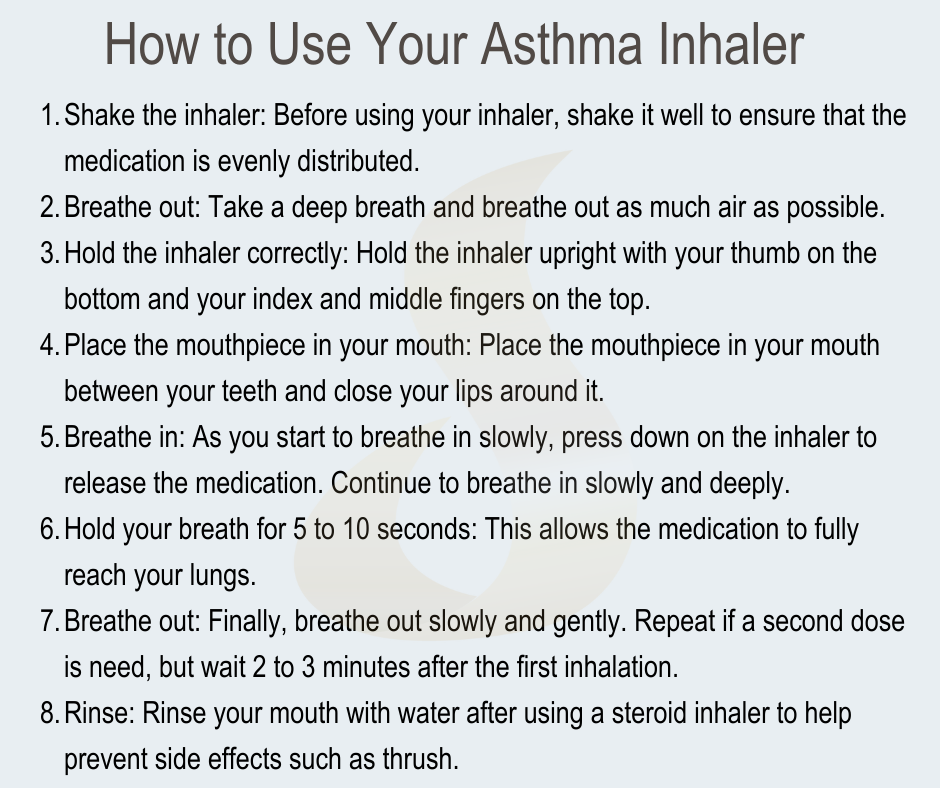What's On This Page?
ToggleAsthma is a chronic respiratory condition characterized by inflammation and narrowing of the airways, which can lead to difficulty breathing, coughing, wheezing, and chest tightness.
According to the World Health Organization (WHO), an estimated 235 million people worldwide have asthma, making it one of the most common chronic lung conditions. In 2020, it was estimated that 461,000 deaths occurred due to asthma or related complications. Here’s a FACT SHEET from their site.
In individuals with asthma, the airways become overly sensitive to certain triggers, such as allergens, irritants, exercise, or respiratory infections. When exposed to these triggers, the airways may become inflamed and constricted, making it difficult for air to flow in and out of the lungs. You hear the wheezing!
Risk Factors for the Development of Asthma
Studies have shown that certain ethnic and racial groups are more likely to develop asthma and experience more severe symptoms than others. In the United States, the prevalence is highest among Black and Puerto Rican individuals. Other groups that have higher rates of asthma include Native Americans, Alaskan Natives, and multiracial individuals.
Studies suggest that women are up to twice as likely to be diagnosed with the reactive airway condition as men. However, the reasons for this are not fully understood. Finally, breastfeeding appears to lower a child’s risk for asthma by strengthening the immune system.
Studies have explored this and the reason that breast milk contains important immune factors that enhance immune function and reduce the body’s reactivity to allergens. Breastfeeding is not a guarantee of perfect lung health in your child, but it does appear to reduce the risk of asthma according to the data I’ve read.
One more interesting detail is that children who were born with low birth weight, or via C-section (Caesarian) appear to have a slightly higher risk of developing the condition later in life. If you’re experiencing post-partum depression, you may be interested in THIS ARTICLE.
Treating Asthma with Medication
Asthma is fairly easy to diagnose, unlike some conditions. The doctor will review the combination of symptoms you’re experiencing as well as your medical history. There will be straightforward lung function tests.
As for treatment, it may include medications that you take orally or those that you ‘spray’ like inhalers. These all require prescriptions. Medications will function as bronchodilators which means they open up the airways allowing oxygen to flow in properly. Physicians will generally tell you to maintain a healthy weight, and avoid triggers if you know them. See below for common triggers.
While there is no cure for asthma, most individuals with it are able to manage their symptoms and lead normal, active lives with appropriate treatment and self-management strategies. Here are the most popular prescription medications used as treatment.

Medications for Asthma
There are several new medications used in the treatment of asthma that has been developed in recent years. Not all of these medications are appropriate for every person, and treatment should be customized to your individual needs and health history.
Here are a few examples:
Inhaled Corticosteroids: This is the first-line treatment and you inhale these into your lungs using a hand-held inhaler or a nebulizer. They work by reducing inflammation in the airways, which helps to prevent asthma symptoms from occurring. Other medications in this list may be used along with corticosteroids to achieve better bronchial control.
Some popular examples of inhaled corticosteroids are:
- Fluticasone propionate (Flovent)
- Budesonide (Pulmicort)
- Beclomethasone dipropionate (Qvar)
- Ciclesonide (Alvesco)
- Mometasone furoate (Asmanex)
Beta-agonists: Short-acting beta-agonist drugs like albuterol are the life-savers! (The long-acting ones don’t work fast and should NOT be used for emergencies).
The short-acting drugs work in the body very quickly and do so by stimulating “beta” receptors in the muscles of your airways. Immediately, the muscles relax and open up which allows for better airflow.
There are two main types of beta-agonists: short-acting beta-agonists, which are used as rescue medications to provide quick relief of symptoms, and long-acting beta-agonists, which are used as maintenance medications to prevent symptoms from occurring.
Some examples of short-acting beta-agonists are:
- Albuterol (ProAir, Ventolin)
- Levalbuterol (Xopenex)
- Terbutaline (Brethine)
Some examples of long-acting beta agonists include:
- Salmeterol (Serevent)
- Formoterol (Foradil)
⚠️ Caution: It’s important to note that while beta-agonists can be effective for managing asthma symptoms, however, can cause side effects such as tremors, palpitations, and headaches. These are especially prominent if your dose is too high.
Triple therapy inhalers: These are inhalers that combine three different types of medication – an inhaled corticosteroid, a long-acting beta-agonist, and a long-acting muscarinic antagonist – in a single device. They are used to treat moderate to severe asthma. A prescription example of this “triple therapy” medication is Trelegy Ellipta® – please ask your physician if it’s right for you.
Leukotriene modifiers: These are a type of medication that block the action of leukotrienes, which are molecules that contribute to inflammation in the airways. They are used to treat mild to moderate asthma. Singulair® (montelukast) is the best example in this category. It blocks cytokines called leukotrienes in the body which would otherwise cause a mess of inflammation and squeeze your airways so that they narrowed.
Montelukast is typically taken orally as a tablet and is used in combo with short-acting beta-agonists like albuterol and/or inhaled corticosteroids like fluticasone.
Biologics: These are a new class of drugs that target specific molecules involved in the immune response that causes inflammation in the airways. They are used to treat severe asthma that is not well controlled by traditional medications.
Some examples of biologics include:
- Omalizumab (Xolair®)
- Mepolizumab (Nucala®)
- Benralizumab (Fasenra®)
Bronchial thermoplasty: This is a procedure (not a pill or inhaler) and it uses heat to reduce the amount of smooth muscle in the airways, which can help improve breathing. It is typically reserved for use in people with severe asthma who did not respond well to other treatments. The FDA has approved the procedure – back in 2010. You can learn more about thermoplasty at the Cleveland Clinic’s WEBSITE.
Tips to Take Medication Safely and Effectively:
Use a spacer: Spacers are devices that can be attached to inhalers to help ensure that medication is delivered deep into the lungs. Using a spacer can improve the effectiveness of inhaled medications and reduce the risk of side effects such as oral thrush.
Follow the dosing instructions: It is important to take asthma medication as directed by a healthcare practitioner and to avoid skipping doses or taking more than prescribed.
Rinse your mouth: If you are using an inhaled corticosteroid, it is important to rinse your mouth with water after each use to help prevent oral thrush.
Keep track of your medication: It can be helpful to keep track of medication use in a diary or app, to ensure that you are taking the correct dosage and not missing doses.
Talk to your healthcare provider: If you have questions or concerns about taking asthma medication, it is important to talk to a healthcare provider for guidance and support.
What are Asthma Triggers?
Asthma triggers are substances or environmental factors that can cause asthma symptoms or exacerbate existing asthma symptoms. These triggers can vary from person to person, but here are some common examples:
Allergens: Substances that can cause an allergic reaction, such as pollen, dust mites, animal dander, and mold.
Irritants: Substances that can irritate the airways, such as cigarette smoke, air pollution, strong odors, and chemicals.
Respiratory infections: Illnesses such as the flu or a cold can trigger asthma symptoms.
Exercise: Physical activity can spark bronchospasm and other asthmatic symptoms in some people.
Weather changes: Cold air, humidity, and changes in temperature can all trigger asthma symptoms.
Emotions: Strong emotions such as anxiety or stress can trigger more symptoms.
Medications: Some medications, such as aspirin and beta-blockers, can trigger asthma symptoms in some people.
It’s important for individuals with asthma to be aware of their triggers and take steps to avoid or minimize exposure to them when possible. This may include using the medication as prescribed, using air filters, maintaining a clean home, and avoiding smoking or exposure to secondhand smoke.

By using your steroid inhaler properly, you can help manage your asthma symptoms and improve your overall quality of life. If you have any questions or concerns about using your inhaler, be sure to talk to your healthcare provider. Also, make sure to clean your inhaler regularly according to the instructions provided by your healthcare provider.
Summary
Prescription drugs are an important component of asthma treatment and can help to improve symptoms, reduce the risk of exacerbations, and improve the overall quality of life for individuals with asthma.
The most commonly prescribed asthma medications include inhaled corticosteroids, which work to reduce inflammation in the airways; long-acting beta-agonists, which relax the muscles in the airways and improve airflow; leukotriene modifiers, which block the effects of inflammatory substances in the airways; and biologics, which target specific inflammatory pathways in the body.
While medications can be effective, they may also cause side effects, and require careful monitoring and dosage adjustments to ensure safe and effective treatment. It is important to work closely with a healthcare provider to develop a personalized treatment plan for asthma. Something I didn’t mention earlier is zinc and its ability to help out with allergies and airway reactivity.* If you’re interested in more information, read 6 Critical Reasons You Need Zinc.
Avoiding triggers is an important part of managing asthma symptoms. Some common triggers include allergens such as dust mites, pollen, and pet dander; irritants such as smoke and pollution; and respiratory infections.
To best avoid triggers, it is important to identify individual triggers through testing or tracking symptoms, and take steps to reduce exposure, such as using air filters, avoiding smoking and secondhand smoke, and practicing good hygiene to prevent the spread of respiratory infections. You may be interested in this article, Alternatives for Smoking Cessation and Lung Health.
How to Use Your Inhaler

If you have asthma, your healthcare provider may have prescribed a steroid inhaler to help control your symptoms. In order to get the most benefit from this medication, it’s important to use it correctly. Here are some tips to help you properly use a steroid inhaler:
- Shake the inhaler: Before using your inhaler, shake it well to ensure that the medication is evenly distributed.
- Breathe out: Take a deep breath and breathe out as much air as possible.
- Hold the inhaler correctly: Hold the inhaler upright with your thumb on the bottom and your index and middle fingers on the top.
- Place the mouthpiece in your mouth: Place the mouthpiece in your mouth between your teeth and close your lips around it.
- Breathe in: As you start to breathe in slowly, press down on the inhaler to release the medication. Continue to breathe in slowly and deeply.
- Hold your breath for 5 to 10 seconds: This allows the medication to fully reach your lungs.
- Breathe out: Finally, breathe out slowly and gently.
- Rinse your mouth: Rinse with water after using a steroid inhaler to help prevent side effects such as thrush.

Suzy Cohen, has been a licensed pharmacist for over 30 years and believes the best approach to chronic illness is a combination of natural medicine and conventional. She founded her own dietary supplement company specializing in custom-formulas, some of which have patents. With a special focus on functional medicine, thyroid health and drug nutrient depletion, Suzy is the author of several related books including Thyroid Healthy, Drug Muggers, Diabetes Without Drugs, and a nationally syndicated column.


